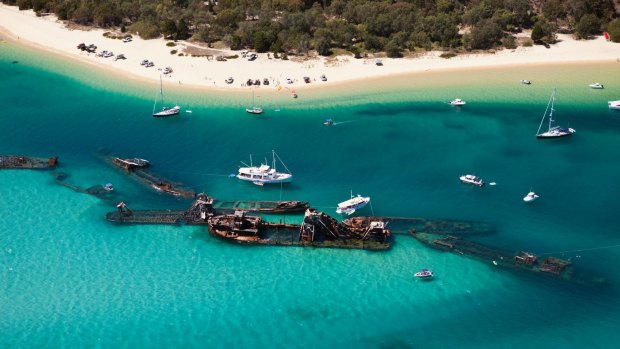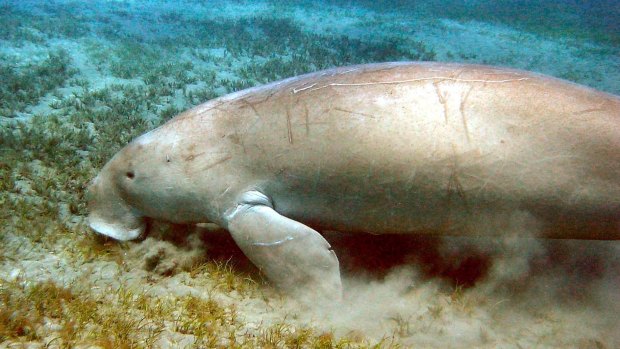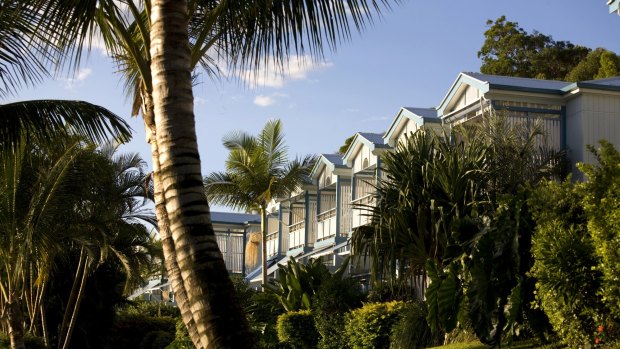This was published 8 years ago
Moreton Bay, Queensland Earthwatch holiday: The ultimate guilt-free holiday

Tangalooma Wrecks, Moreton Island, Brisbane,Credit: Alamy
The glittering waters of Moreton Bay off Brisbane have a secret. Beneath the hulls of the Moreton Island ferry, the yachts and other pleasure craft that speed across its surface, there is an abundance of life: corals and fields of seagrass, two kinds of dolphin (bottlenose and the rare Indo-Pacific humpback dolphin), six of the world's seven species of sea turtle (including 10,000 green turtles), migrating whales (July-October), more than 750 species of fish – and up to 1100 dugongs.
Listed as a marine park in 1993, Moreton Bay is one of the top 10 dugong habitats in Australia and the only place in the world where "herds" of up to 100 live close to a major city.
But increasing coastal development, freight traffic and mud from the 2011 and 2013 floods in south-east Queensland have been putting stress on the bay.

A dugong feeding on sea grass in Moreton Bay, Queensland. Credit: Ruth Hartnup, Earthwatch Institute
For the past 15 years, Healthy Waterways, an independent not-for-profit based in Brisbane, has been monitoring and reporting on Moreton Bay's seagrass (which dugongs depend on) and other aquatic ecosystems in the area. But collecting data is labour intensive and there is always more field work to be done than there are scientists to do it.
That is where Australia's largest airline and the world's largest private funder of scientific research come in.
Last month , in an industry first, Qantas joined with Earthwatch Australia to offer a range of sustainable travel experiences to its frequent flyer members – non-members will soon be able to access the trips, too.

Cottages at Tangalooma Island Resort.
There are 11 experiences so far: six Earthwatch trips where volunteers help scientists in locations ranging from Orpheus Island on the Great Barrier Reef to the Otways in Victoria; three ecotourism treks in Tasmania (the Cradle Mountain Huts Walk on the Overland Track, the Bay of Fires Lodge Walk and the Wineglass Bay Sail Walk, all run by Tasmanian Walking Company); and two cultural adventures with Lirrwi Tourism in north-east Arnhem Land.
Teaming up with Qantas enables Earthwatch to promote its trips to the airline's 10.7 million frequent flyer members worldwide – and not just in the name of doing more scientific research.
"It's a big help to the scientists – from universities, the CSIRO, the Australian Institute of Marine Science – but these trips also have a multitude of positive impacts for the participants," says David McInnes, CEO of Earthwatch Australia.
"The people who participate in these expeditions go back into their communities as much more informed advocates for the environment. So the research outcomes are improved, more science is done in the field, and the individuals are enriched in their knowledge and their advocacy for the environment. For some people it can be a life-changing experience."
And the benefits for Qantas? According to Alan Milne, head of environmental management at Qantas, promoting sustainable tourism is not just about "ticking a corporate social responsibility box" or cashing in on the rise of nature-based tourism; 66 per cent of all international visitors to Australia last year participated in nature-based activities – and spent $23.2 billion on those activities.
"We're doing this because we know it's the right thing to do," Milne says. "Yes, we're an airline; yes, we're a carbon emitter, but we're going to do everything we can possibly do to minimise our impact, to lead the [aviation] industry and to ensure that the industry is minimising its impact."
As the largest private investor in tourism in Australia, Qantas is also committed to "growing the tourism industry in an economic, socially and environmentally sustainable manner", he says.
It's all part of Qantas' ongoing sustainability program. Since 2007, the airline has been reducing its carbon emissions, increasing fuel efficiency, developing sustainable aviation fuels and finetuning its carbon offset program, which has the highest uptake of any airline offset program in the world (7 per cent of Qantas passengers offset their flights).
It's a cool, overcast morning when my fellow citizen-scientists step aboard the 12-metre catamaran Velella, anchored off Tangalooma Island Resort. Occupying just 2 per cent of this national park island, Tangalooma is best known as one of the only places in the world where you can hand-feed wild dolphins and it has a strong sustainability focus; it also has an eco-certified Marine Education and Conservation Centre and runs a world-first environmental school program.
We're here to spend the day on the water, however, for a taste of one of the first Qantas-Earthwatch experiences: a seven-day Snorkel for Queensland's Marine Mammals trip, which launches next month, offering participants the chance to help scientists monitor seagrass.
"Seagrass meadows are the rainforests of the ocean," Dr James Udy says. He is chief scientist at Healthy Waterways and our leader for the day. "They have some of the highest productivity of any habitat on earth and provide critical habitat that supports life in the bay."
As the wind picks up, we wriggle into wetsuits, grab snorkels, masks and fins, and hop into an inflatable dinghy to motor close to shore, where seagrass grows. Unfortunately, the sea is too rough to collect samples, but we spend an interesting couple of hours with Udy, who points out various seagrass species, shows us how the sampling is done, and explains the difference between seagrass and seaweed (the former is a flowering plant that returned to the sea, the latter an algae).
Back on Velella for lunch, we warm up in the sun, then sail to "the wrecks" – a breakwall of 15 ships scuttled in the 1960s to provide a safe anchorage for visiting boats – where a few of us jump into the water again to snorkel with colourful tropical fish and corals. Then it's back to the resort for hot showers before our late-afternoon ferry back to the mainland. Research-wise, the day has been a wash-out, but it's easy to see how people get hooked on scientific volunteering.
"Not everyone will want to participate in an Earthwatch expedition," David McInnes says. "But for those people who do, it adds another dimension to their experience in that they know they're contributing to recognised research, they get to explore an environment they might not otherwise have access to, and, importantly, it's recreation time with a purpose: making a real, and lasting contribution to a more sustainable environment. Not many people get an opportunity to make such a contribution in their daily lives, let alone on their holidays."
TRIP NOTES
MORE INFORMATION
qantas.com.au/travel/airlines/sustainable-tourism/global/en; au.earthwatch.org; healthywaterways.org
SEE + DO
Earthwatch's inaugural seven-day Snorkel for Queensland's Marine Mammals trip on Moreton Island departs August 16. Cost is $2995 or 503,000 Qantas Frequent Flyer points, including accommodation at Tangalooma Island Resort, all meals and a $100 Qantas flight voucher. See qantas.com.au/sustainabletourism; www.tangalooma.com/info/home/
The writer was a guest of Qantas, Earthwatch and Tangalooma Island Resort.
FIVE MORE SUSTAINABLE TOURISM TRIPS
PROJECT MANTA An eight-day trip for experienced divers to photograph and study the world's largest ray, staying at Lady Elliott Island Eco Resort, Queensland.
WINEGLASS BAY SAIL-WALK A four or six-day trip that involves exploring Tasmania's east coast on foot and by sea, staying each night on a 23-metre luxury yacht.
GAY'WU DILLYBAG WOMEN'S TOUR A seven-day immersion, for women only, into the world of the Yolngu women of north-east Arnhem Land, run by indigenous operator Lirrwi Tourism.
MICROBATS OF MELBOURNE A one-day, dusk-to-dawn adventure, trapping and banding some of Melbourne's 15 species of tiny microbats, staying overnight in the Royal Botanic Gardens.
WET TROPICS WILDLIFE A one or two-week trip to survey birds, lizards and nocturnal wildlife in the rainforests of Far North Queensland, with camping and cabin-stays.
Sign up for the Traveller Deals newsletter
Get exclusive travel deals delivered straight to your inbox. Sign up now.